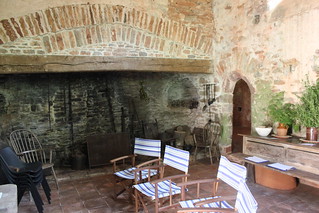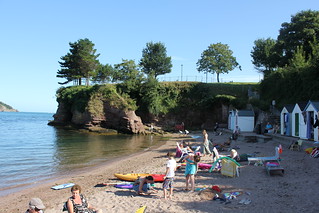Synopsis: Long on my To Do list, finally I get around to completing this walk that includes my first visit to Compton Castle (NT). Unexpectedly beautiful countryside considering so close to busy Torquay.
For some time I had hoped to visit Compton Castle (NT) but hadn’t got around to it. I thought it would be nice to visit the castle as part of a bus walk, and plotted this route from Abbotskerswell to Torquay some time back, since which time it has sat in my ‘Walk Ideas’ folder on my computer. But today was the day it was dusted off. I must mention that Compton Castle is only open on certain days of the week (3 days/week at time of writing), therefore a check of the opening times is essential prior to any intended visit.
My bus dropped me on the outskirts of Abbotskerswell, a schizophrenic place. A sort of, tale of two villages. A place that has great charm in the quaint and beautiful cottages dotted along winding lanes, or a sprawling bungalow village, depending on how you approach it. Because of these multiple layers, my recommendation would be, don’t give up on it if at first it seems a little unappealing, but search a little deeper. Court Farm, today an inn, is very picturesque.
The Church of St Mary (Listed Grade II*), is tucked away up a little lane and, although heavily restored, has points of interest. And the heart of the village tenaciously clings on to its past heritage despite the siege taking place on its perimeter.
There is a heavily mutilated sculpture in one corner of a south window in the church chancel that fascinates me. I’d read a little about it on a previous visit of mine. There are two schools of thought regarding it. The official listing of the church describes it as The Virgin Mary. Others suggest she is Oedehild, daughter of Edward the Elder [r. 899-925]. I don’t have the scholarly knowledge to judge, but I love the history of the latter, so I’m going with that belief.
A word of warning: Windmill Lane is a euphemism for a lane. I suppose one might refer to it as a green lane. The finger post says, ‘Unsuitable for Vehicles’. I’d like to add, ‘And the rest’. It is something of a jungle battle for which a machete would not be amiss. Narrow and overgrown, with many a nettle to sting and a thistle to prick, it was not the most pleasant 0.6 mile (between here and here) of my walk today. Definitely one for the Bear Grylls in you. In compensation for the tough progress along Windmill Lane, there are the occasional views that are quite breath taking.
I started my visit of Compton Castle with a tour of the garden, which includes a rose garden and a knot garden. There is also a private garden towards the back of the castle. The original owners, dating back to Elizabethan times, the Gilberts, are still in residence today, which to my mind adds to the historic pedigree of the property. Humphrey Gilbert (1539-1583) played a significant roll in opening up America as a British colony during the reign of Queen Elizabeth I, a fact honoured by Americans through the presentation in recent times of plaques to the Gilberts which are to be found hung in the chapel. It could be said America began here.
From the garden I walked across the front aspect of the castle with it’s impressive fortifications highly visible to this day. The placement for the portcullis is very visible, as are the chutes down which rocks or boiling tar could be thrown on attackers. And one can imagine the arrows raining down from the battlements and the slotted windows on those below. The castle’s defensive were certainly more substantial than I had imagined they would be.
Walking through an archway I entered the rear garden planted with herbs. In the far corner, in a separate building so as to reduce the risk of a fire potentially spreading to the house, was to be found the kitchen. This rather primitive room I thought was most evocative of how a medieval kitchen must have appeared. A huge 3-flue chimney spans the length of one wall. One can just imagine a hog roasting on the spit, juices flowing and smells wafting in the air.
From the kitchen I walked around the corner to where the old well was to be found. This, standing under the protection of the 7m high curtain wall, has, for safety reasons, been filled in some time ago. Anyone who has watched Batman Begins will know just how dangerous wells can be.
I then entered the Great Hall which is approached through a hall running from the rear garden to the front courtyard. It appears very much as it would have appeared in medieval times, although all the furnishings and decoration are modern. The Gilbert family had repossessed Compton Castle in 1931 and had set about restoring much of the castle that had laid unoccupied for nearly 150 years. A condition of the house being gifted to the National Trust in 1951 was that the last remaining room to be restored, the great hall, would be restored by them. A caveat of the gift allows Gilberts residence at the castle in perpetuity.
Compton Castle has two Solar (rooms), a Sub-Solar (ground-floor) and a Solar (first-floor). It was explained to me, that these rooms were incorporated into medieval manor houses for the purpose of offering the occupying family some privacy, away from the communal space of the great hall. A space in which one could be solitary (well, almost), at least in the sense of being secluded or isolated from the throng. Both rooms are open to the public.
And one final room, almost missed by me, but pointed out by one of the stewards, was the chapel. It’s rather an unassuming corner of the castle, and easy to see how I nearly overlooked it. For me, the main items of interest were the plaques which Americans have dedicated to the Gilberts which commemorate the family’s roll in establishing New Found Land.
Time was marching on and I had a bus to catch. I set off down (and up) lanes in the general direction of Torquay. I came across the extremely busy A380, the crossing of which was a little unnerving. I then entered fields before picking up a track which took me into the back of Cockington Court. I walked through the grounds and into Cockington Village where I picked up a path that followed a stream leading all the way down to the seafront.
Holidaymakers were enjoying the warm summer sunshine, splashing in the sea from the little beach at Corbyn’s Beach. I could see children rock pooling as well. And in the distance I could also see that the fair was in town. All the timeless things that make up the seaside experience were in play, just as they always have been, and probably always will be.
A very enjoyable walk and an extremely interesting castle. Another day well spent.
Note: My walk distance includes meanderings around Compton Castle and Gardens, so if that is excluded, the pure walk distance is more like 9.1 miles.
Walk Statistics (includes time at Compton Castle):
Total Distance: 11.5 miles (9.1 miles without meandering around Compton Castle)
Moving Time: 3hrs 38min
Stopped Time: 1hr 19min
Total Ascent: 315 metres
Maximum Elevation: 145 metres
Buses: X64 & X46

















No comments:
Post a Comment